Wallasey Golf Club
Wirral, England

More than half the holes at Wallasey play over, through and around large dunes, offering golf as inspiring as nearly any course found in the United Kingdom. The remaining holes are on flatter land and are less compelling. Nonetheless, its excellent routing comes in and out of the dunes, mixing the dunes holes throughout the round and thus holding the golfer’s full attention.
What are the attributes that make a great routing? The short answer is that a great routing yields the best sequence of holes from the property, capturing many of the property’s most appealing features. By doing so,the holes themselves and their pacing throughout the roundre main unique unto that particular property, a very good thing as the course will enjoy its own individual character. Unfortunately, for the period from the 1950s through much of the1980s,residential development drove golf course construction. Architects were rarely free to work with large contiguous blocks of land; huge allowances had to be made for the placement of homes along numerous fairways.Routing a course became less about connecting the site’s interesting features through successive golf holes and more about the required sacrifices to allow for prime golf course frontage for homes. Green to tee walks swelled, making riding in a motorized cart an attractive option. Heinous cart paths ensued, forever marring the landscape. For a host of reasons, with the property no longer strictly reserved for just golf, the quality of the resulting golf courses sunk to a low. Mercifully, the great old courses in the United Kingdom were built long before residential courses became the driving force. Throughout the Golden Age of architecture, the best property was reserved for golf – and it shows in the amazingly high quality of golf courses scattered throughout the United Kingdom. One example of a very fine routing on a contiguous rectangular block of land is found at Wallasey Golf Club, a twenty minute drive north of its famed neighbor Royal Liverpool Golf Club.The golfer starts the round in a rousing fashion among the dunes and is transported to the shoreline by the 4th tee. The 4th and 5th play hard by the Irish Sea, affording the golfer lovely views before the course heads inland for the next four holes. Just when the golfer hopes to seethe sea again, he finds himself on the elevated 10thgreen and right back in the heart of the big dunes country. For many, the 11th is the finest hole on the course, a timely reminder of the merit of a game at Wallasey. A fine drop shot one shotter descends the golfer out of the dunes and back in the flat portion of the property. Two consecutive three shotter seat up the modestly interesting land before the golfer re-enters the dunes for one of the game’s finest four hole finishing stretches. The rhythm of the course is thus such: a thrilling start with five links holes,four holes on the less distinguished portion of the property, a transition hole followed by a super lative two shotter in the wild dunes, another quiet moment of several holes and then the fantastic four hole finish among the dunes. In short, the golfer starts in the dunes, returns to the dunes at the start of the second nine, and finishes in the dunes. This coming in and out of the best property keeps the golfer looking forward to whatever is next. The golfer is almost willing to overlook some of the pedestrian holes in the flats in the middle of each nine as he knows that something grand isn’t too far away.
To appreciate fully the flow of the course, let’s go on a tour. In the finest UK tradition, the 1st tee box is hard by the clubhouse. Unlike the ho-hum start at Hillside or Royal Lytham & St. Annes up the coast, the golfer is greeted by his favorite sight: a fairway bobbing up and over a dune to aclassically sunken green.
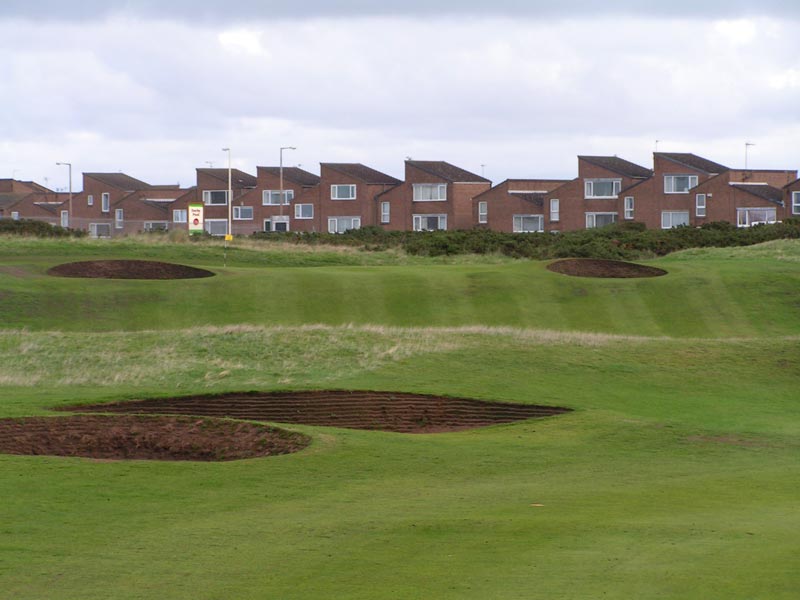
Though the backdrop is unappealing, the golfer’s eye from the elevated 360 yard first tee is drawn toward the rumpled landscape. The pair of bunkers in the foreground are 135 yards from the green in the far hollow.
The 2nd and 3rd holes continue the links feel established at the 1st. The 2nd playing through a valley is the longest two shotter on the course but its relatively level fairway offers the golfer hope of a decent stance for his long approach shot. The 3rd is back into the bigger dunes with its elevated green featuring a pronounced back to front pitch.
The golfer is only at the 4thtee but he finds himself standing on the prettiest spot on the course, high above the coastline with commanding long views in all directions. This splendid tee location confirms what the golfer already senses: the decision to play Wallasey was a wise one. The three shot4thstretches below as it hugs the Irish Sea for more than 530 yards.
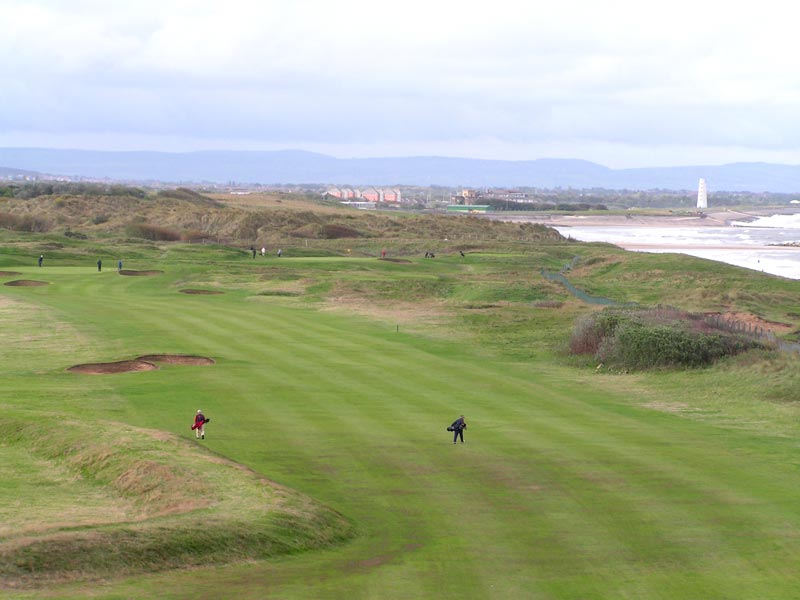
Standing on the fourth tee, the golfer soaks in the coast and the glories of Wallasey.
After leaving the 4th green, the golfer once turned right and played the one shot 5th parallel to the coastline. In the 1960s, a new tee was created left of the 4th green. From its new elevated perch,the Irish Sea is the backdrop and the golfer plays a shot at an angle into the wind that he otherwise would not.For these reasons, the left tee is a handsome addition to the course.
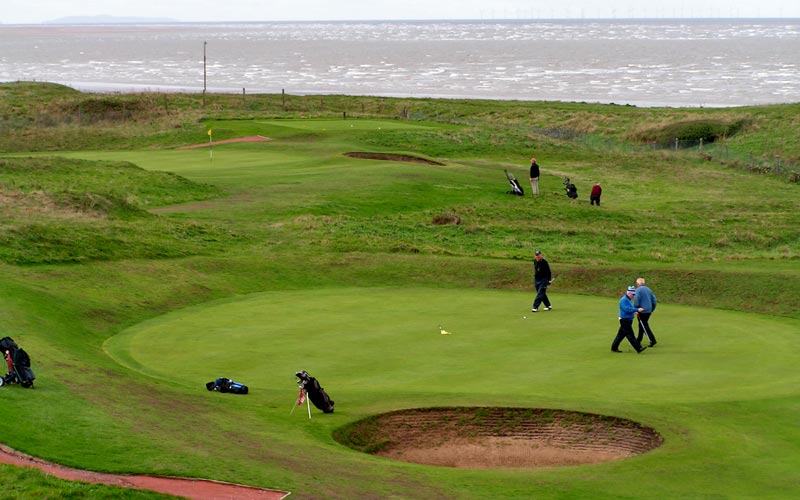
Golfers now exit the fourth green (pictured in the foreground) to the left and walk up a dune to play down to the fifth green 175 yards in the distance.
Wallasey turns inland with the 6th tee ball. Though its tee is on the coast, the hole plays directly away from the water and the golfer doesn’t see the water again until the 10th green.The 6th green requires a clever enough pitch but the three shot 7th is a dullard. Played along the meadowy, flat portion of the property, the hole lacks width to create interesting playing angles. Fortunately, this hole is followed by the best inland hole on the course, the 395 yard 8th. Borrowing from Hoylake, the Club uses internal out of bounds to lend this hole some real menace.
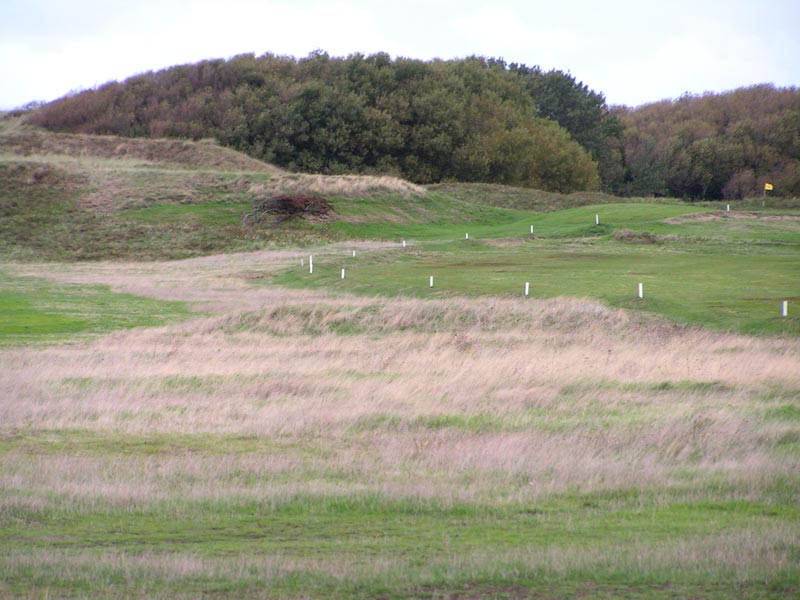
The view from the sharp dogleg right eighth tee: the green’s yellow flag is visible well to the right but so are the out of bounds white stakes. The fairway and the golfer’s line off the tee are to the left of the photograph.
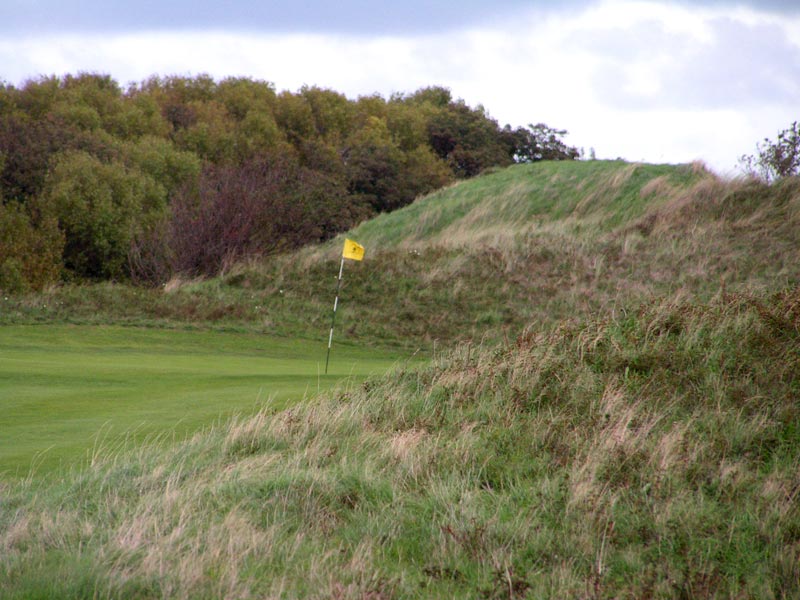
Once around a dune on the inside of the dogleg, the 8th green reveals itself.
The 145 yard one shot 9this to a pushed-up green that can be nearly impossible to hold when the wind is up. More times than the golfer might hope on a hole of such modest length, he finds the need to make a nifty pitch and one putt to get his par.
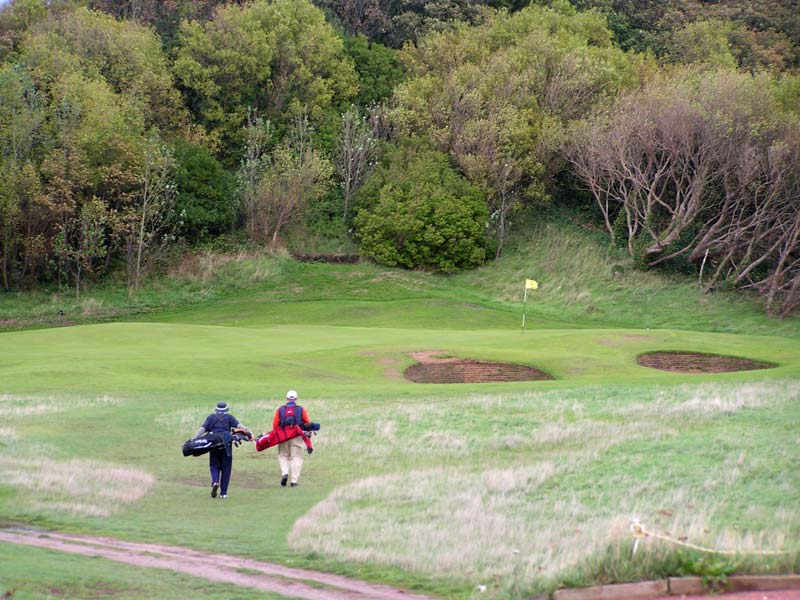
The course’s inland character is evident in this view from the tee of the 145 yard ninth hole.
The 10th tee ball maintains an inland feel as trees guard the inside of the dogleg right. However, the green is atop a dune, delighting the golfer with the return to the prime golf country.
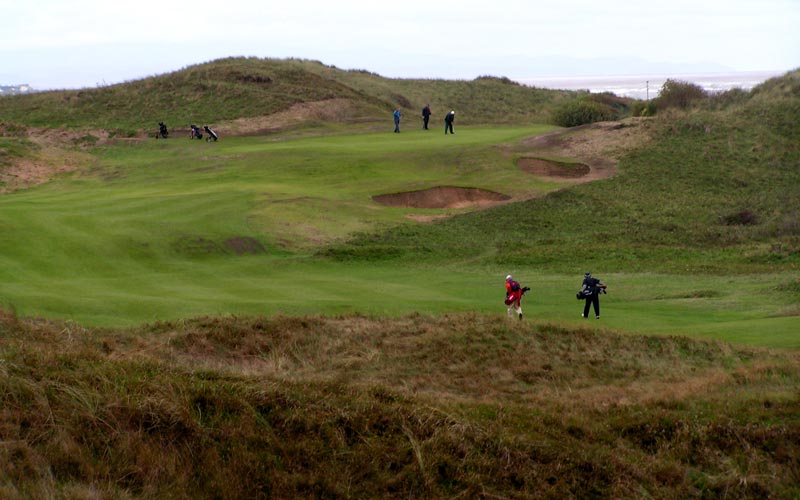
Steel’s newly created eleventh green sets at a 45 degree angle to the fairway, a design tact that the great William Flynn employed with great success at many of his finest designs, including Shinnecock Hills. Here at Wallasey’s eleventh, any approach shot just short of the shelf green rolls well back down, frequently into the bunker at the base of the dune, leaving a horribly difficult recovery shot.
The one shot 12th plays from a dune to the lower, flatter portion of the property. The green itself is original to Old Tom Morris’s 1891 design and is ringed by five bunkers. Flighting one’s ball though the wind to the tightly defined target is the task here. The next two holes are back to back three shotters that parallel each other. Like the 7th, which they unfortunately parallel as well, the holes lack sufficient strategic merit to engage fully the golfer. Chewing up the least appealing land with long holes is a fine design strategy but the shot themselves want for interest. Wallasey Golf Club realized this shortcoming and Steel’s recent work to the 13th hole makes it the best of the three inland three shotters as a spine of dunes land is brought into play. Still,its lack of width leaves but few decisions. The golfer uses this moment in the round to consolidate his score and as a breather before one of the game’s great finishing stretches.
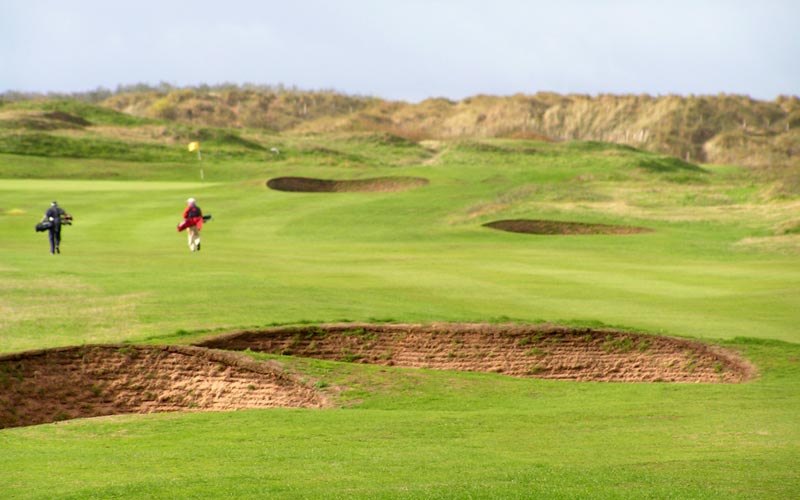
New bunkering schemes have been introduced to the holes on the flatter property in an effort to add more playing interest.
After having played over 1,000 yards in two holes of not great golf, the golfer delights when he sees that the 15th tee points him in a westerly direction, which is to say right back into the dunes country, from where the last four holes are played.Apart from the obvious reason of staying in the dunes, one of the reasons that the finish is so good is because of the variety of the final four green complexes. For instance, the one here at the 15th is raised and bunkerless whereas the one at the 18th is sunken and guarded by three bunkers.Though the golfer’s tee ball at the 15th stays down on the flat, the approach shot is one of the more vexing on the course as the golfer needs to judge the effect of the wind high above.Coupled with the sharp embankment before the green, the visiting golfer almost always is at least one club short on his approach.
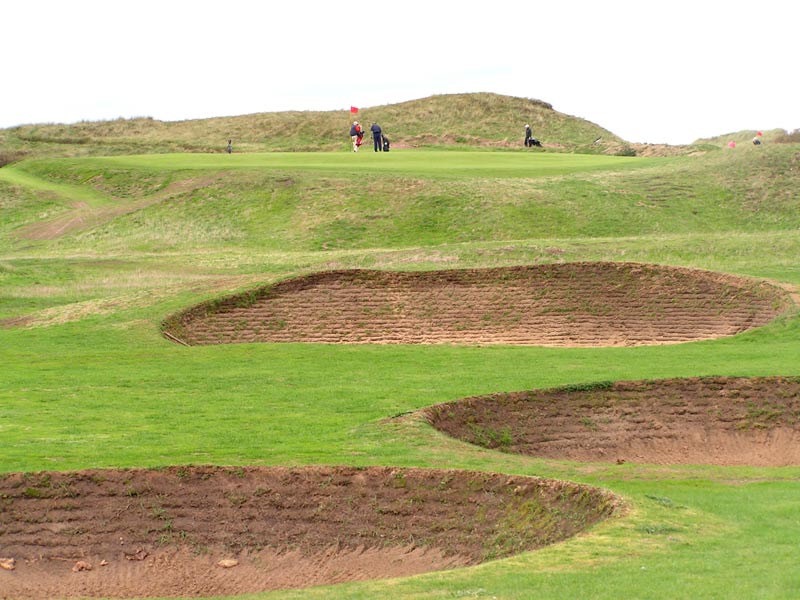
A nest of three fairway bunkers push the golfer right off the fifteenth tee. The approach to the elevated green is often into the prevailing wind off the sea.
The benefits of great topography are never more evident than at the 195 yard 16th:the tee is on one dune and the green is on another,a long way away. Nothing too complex and the hole is all the better for it as its appeal is entirely natural.Especially when the wind roars in off the Irish Sea,playing the 16threpresents man vs. nature on a great scale.
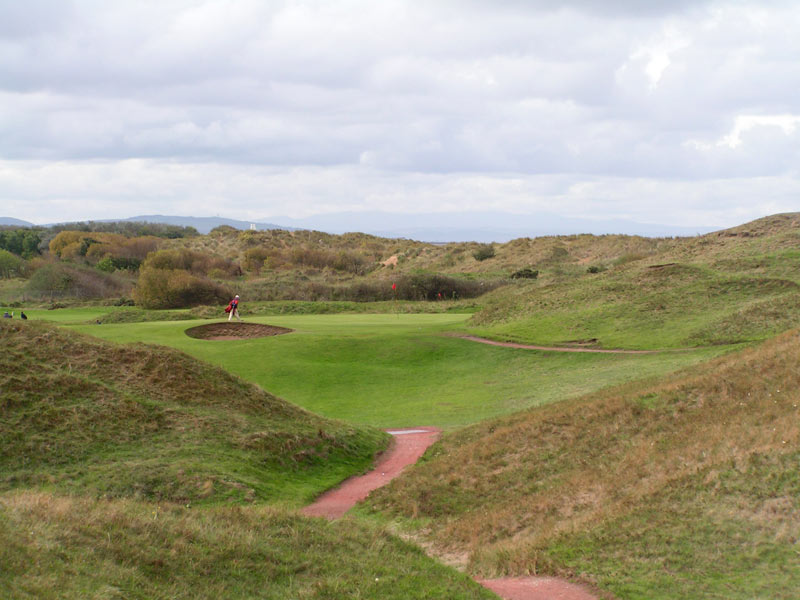
The justly famous 195 yard sixteenth hole calls for a long and true shot, played from one dune top to another one through a valley created by even larger dunes.
The 455 yard 17thparallels the 4th and offers nearly as spectacular views though it heads in the opposite direction. The fairway swings to the right 330 yards from the tee and seemingly disappears into towering dunes. The golfer dearly likes to shorten this long two shotter by playing down the right but anything in the right edge of the fairway leaves a blind approach shot over massive dunes to a green in a dell.
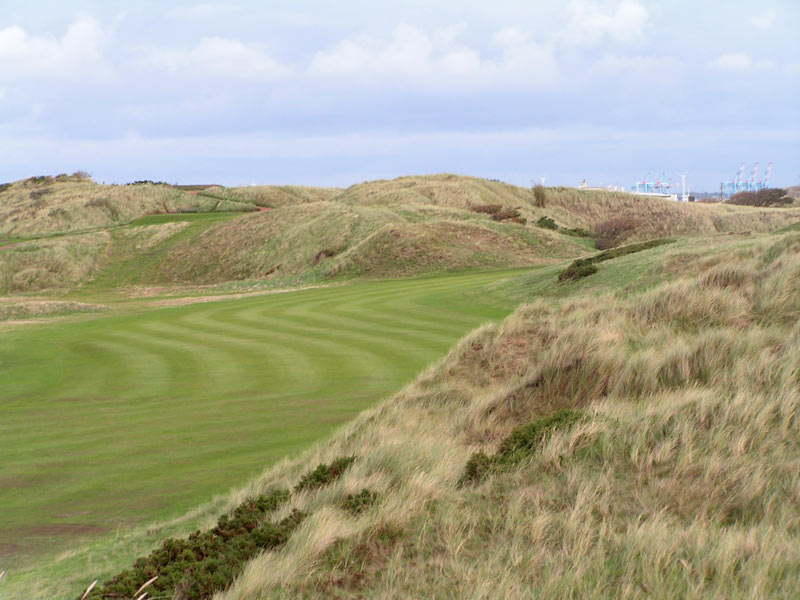
The view from the seventeenth tee shows the fairway as it swings to the right through the dunes. Pictured above left is the fourth tee.
The Home holes on many of the famed English clubs are generally situated across some of the less compelling land. Examples include all the courses on the current Open rota, namely Royal Birkdale, Royal St. George’s, Royal Lytham & St. Annes, and Royal Liverpool. All are fine to excellent finishing holes but that’s due to the man made features as opposed to natural ones. Such is not the case at Wallasey as the 18th is routed over some of the property’s most rambunctious land forms. A wonderful finish made all the better by the fact that members in the clubhouse absorb the drama as it unfolds on the green situated below the clubhouse. What a sight it would have been to see Bob Jones playing down this fairway on his way to qualifying for the 1930 Open!
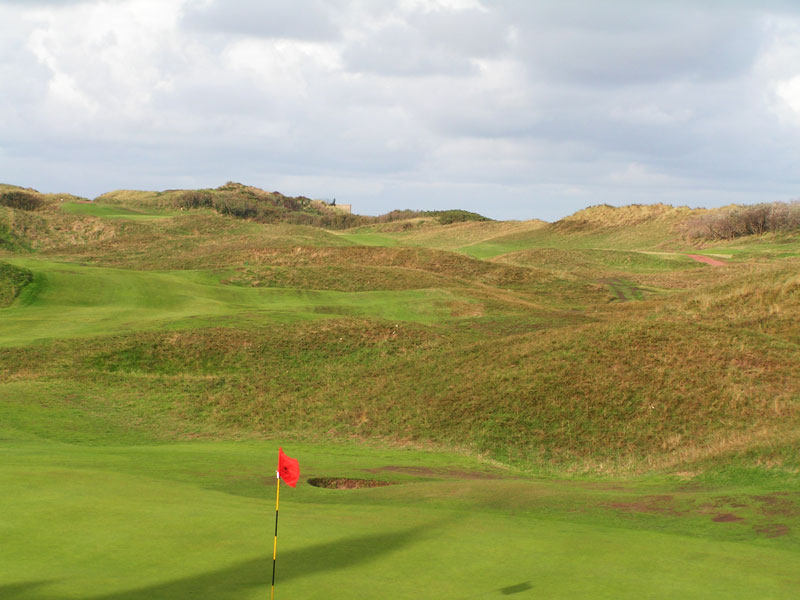
The shadow from the clubhouse speaks to its proximity to the eighteenth green.
As is evident in the view back down the 18th fairway in the photograph above, Wallasey is blessed with much land that is ideally suited for golf. When the course gets out of that land, the quality of the holes suffers. Mercifully,such stretches of holes are only brief. Thanks to its excellent routing that spreads the dunes holes throughout the round, a golfer always delights in a round at Wallasey.
The End

